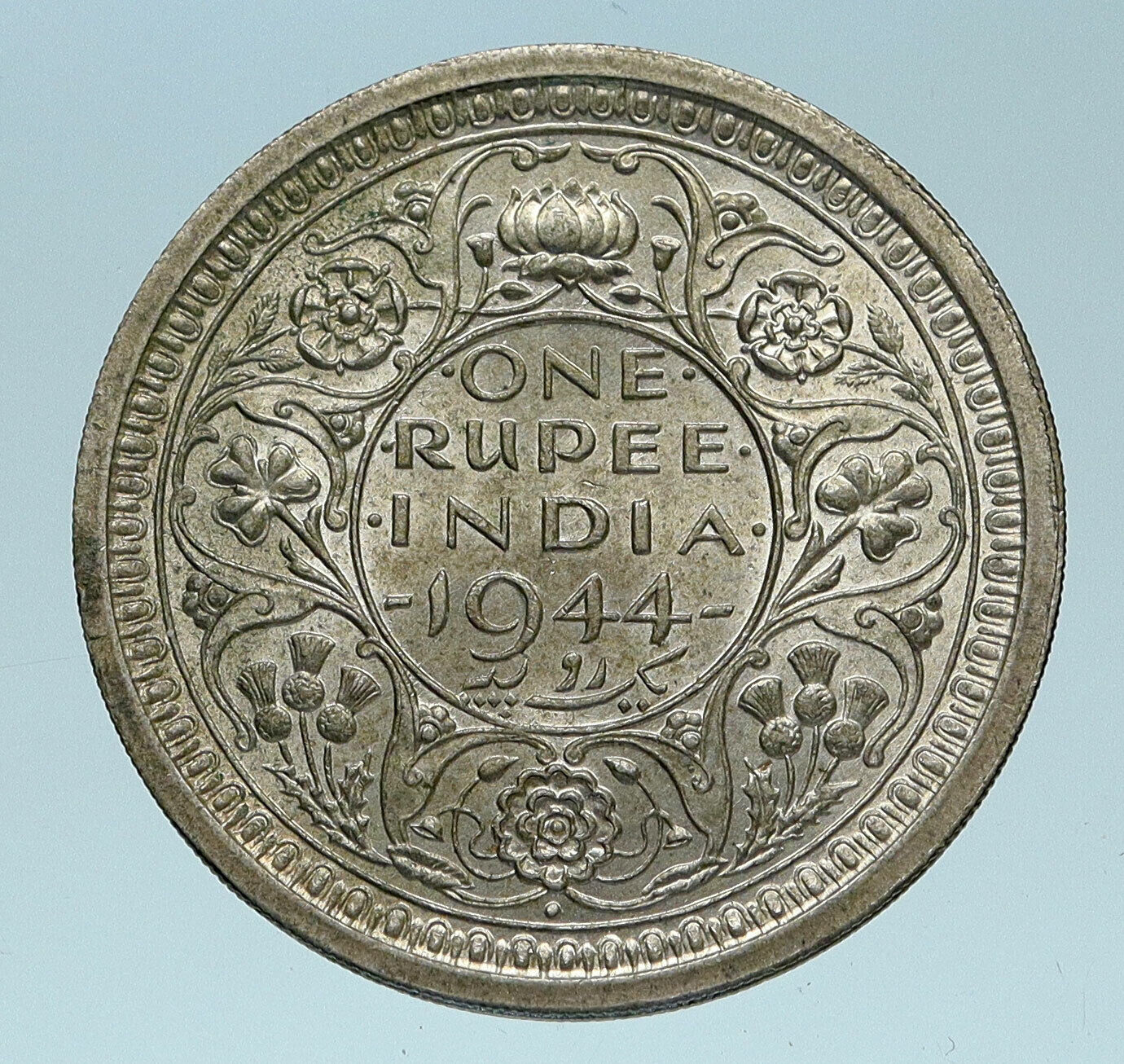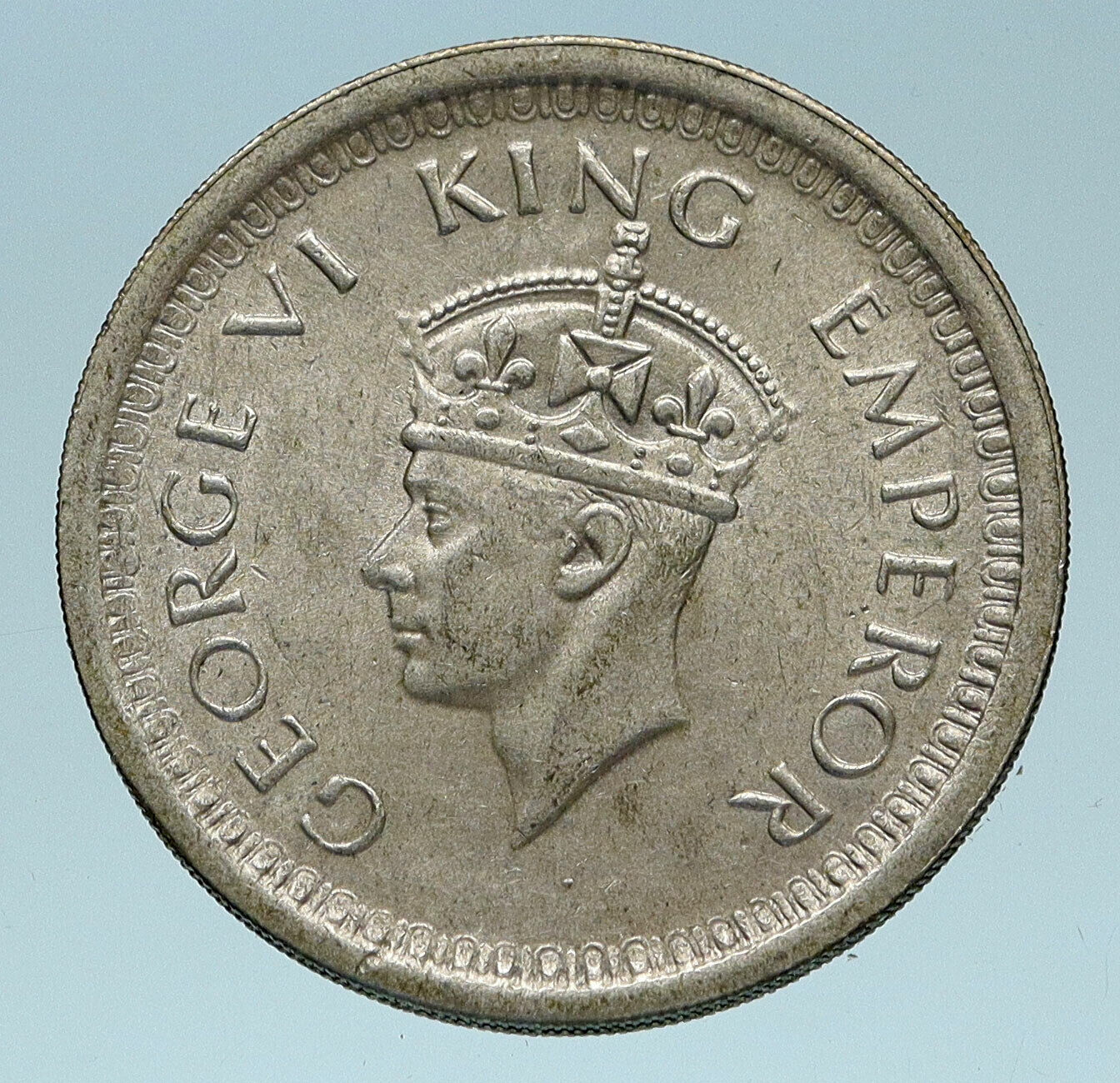|
India under George VI – King: 11 December 1936 – 6 February 1952
1943 Silver 1/2 Rupee 24.1 mm (5.83 grams) 0.500 Silver (0.0939 oz. ASW)
Reference: KM# 552
GEORGE VI KING EMPEROR, King George VI facing left.
HALF RUPEE INDIA, Within circle, date divides legend in English & Persian (Hasht Aanay). Outside circle, wreath made of roses, thistle, shamrock leaves and lotus flowers.
You are bidding on the exact item pictured, provided with a Certificate of Authenticity and Lifetime Guarantee of Authenticity.
George VI (Albert Frederick Arthur George; 14 December 1895 – 6 February 1952) was King of the United Kingdom and the Dominions of the British Commonwealth from 11 December 1936 until his death. He was the last Emperor of India and the first Head of the Commonwealth.
Known as Albert until his accession, George VI was born in the reign of his great-grandmother Queen Victoria, and was named after his great-grandfather Albert, Prince Consort. As the second son of King George V, he was not expected to inherit the throne and spent his early life in the shadow of his elder brother, Edward. He attended naval college as a teenager, and served in the Royal Navy and Royal Air Force during the First World War. In 1920, he was made Duke of York. He married Lady Elizabeth Bowes-Lyon in 1923 and they had two daughters, Elizabeth and Margaret. In the mid-1920s, he had speech therapy for a stammer, which he never fully overcame.
George’s elder brother ascended the throne as Edward VIII upon the death of their father in 1936. However, later that year Edward revealed his desire to marry divorced American socialite Wallis Simpson. British Prime Minister Stanley Baldwin advised Edward that for political and religious reasons he could not marry a divorced woman and remain king. Edward abdicated in order to marry, and George ascended the throne as the third monarch of the House of Windsor.
During George’s reign, the break-up of the British Empire and its transition into the Commonwealth of Nations accelerated. The parliament of the Irish Free State removed direct mention of the monarch from the country’s constitution on the day of his accession. The following year, a new Irish constitution changed the name of the state to Ireland and established the office of President. From 1939, the Empire and Commonwealth – except Ireland – was at war with Nazi Germany. War with Italy and Japan followed in 1940 and 1941, respectively. Though Britain and its allies were ultimately victorious in 1945, the United States and the Soviet Union rose as pre-eminent world powers and the British Empire declined. After the independence of India and Pakistan in 1947, George remained king of both countries, but relinquished the title of Emperor of India in June 1948. Ireland formally declared itself a republic and left the Commonwealth in 1949, and India became a republic within the Commonwealth the following year. George adopted the new title of Head of the Commonwealth. He was beset by health problems in the later years of his reign. He was succeeded by his eldest daughter, Elizabeth II.
Colonial India is the part of the Indian subcontinent which was under the control of European colonial powers, through trade and conquest. The first European power to arrive in India was the Macedonian army of Alexander the Great in 327-326 BC. The satraps he established in the north west of the subcontinent quickly crumbled after he left. Later, trade was carried between Indian states and the Roman Empire by Roman sailors who reached India via the Red Sea and Arabian Sea , but the Romans never sought trading settlements or territory in India. The spice trade between India and Europe was one of the main types of trade in the world economy and was the main catalyst for the period of European exploration .[1][2] The search for the wealth and prosperity of India led to the accidental “discovery” of the Americas by Christopher Columbus in 1492. Only a few years later, near the end of the 15th century, Portuguese sailor Vasco da Gama became the first European to re-establish direct trade links with India since Roman times by being the first to arrive by circumnavigating Africa (1497-1499). Having arrived in Calicut , which by then was one of the major trading ports of the eastern world,[3] he obtained permission to trade in the city from Saamoothiri Rajah . Trading rivalries brought other European powers to India. The Netherlands , England , France, and Denmark established trading posts in India in the early 17th century. As the Mughal Empire disintegrated in the early 18th century and then the Maratha Empire became weakened after the third battle of Panipat , the relatively weak and unstable Indian states which emerged were increasingly open to manipulation by the Europeans through dependent “friendly” Indian rulers. In the later 18th century Britain and France struggled for dominance through proxy Indian rulers and also by direct military intervention. The defeat of the redoubtable Indian ruler Tipu Sultan in 1799 marginalised French influence. This was followed by a rapid expansion of British power through the greater part of the subcontinent in the early 19th century. By the middle of the century, the British had already gained direct or indirect control over almost all of India. British India contained the most populous and valuable provinces of the British Empire and thus became known as “the jewel in the British crown”.
|










